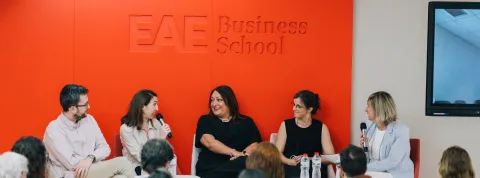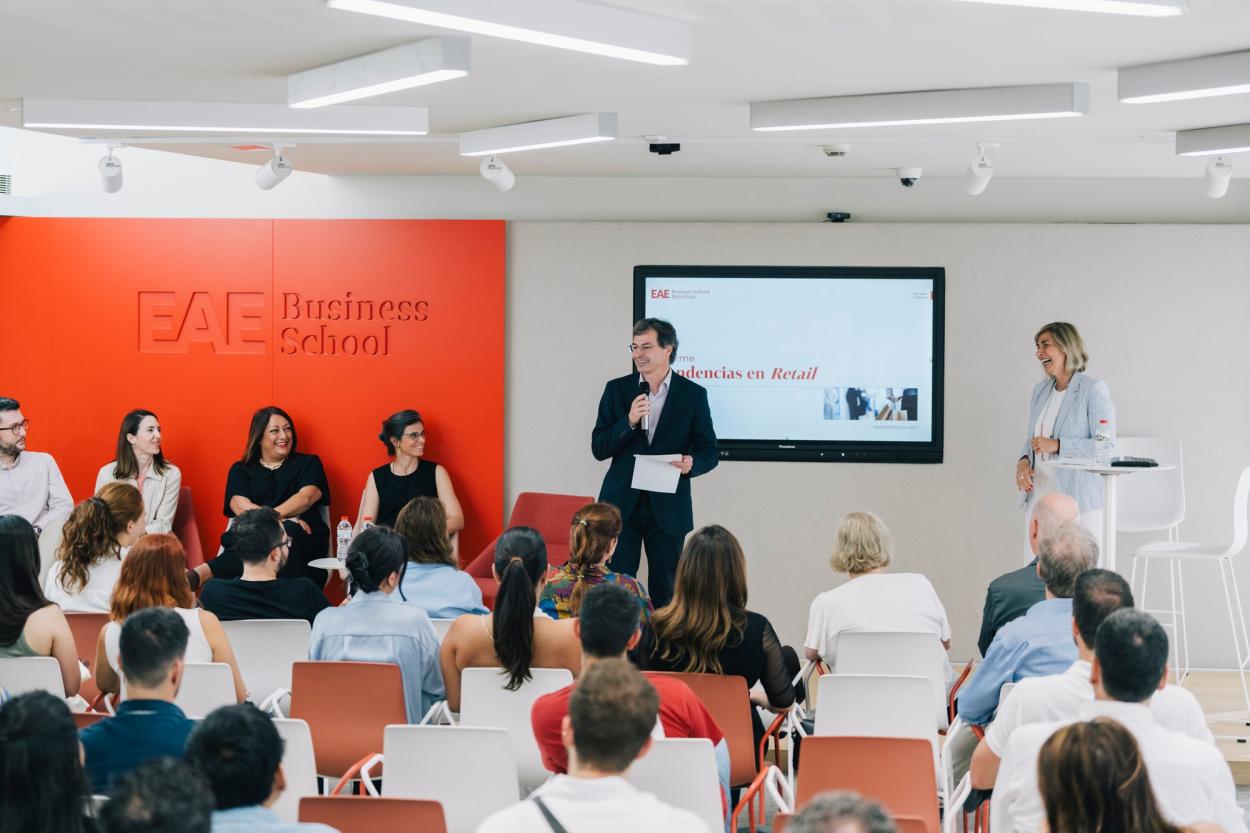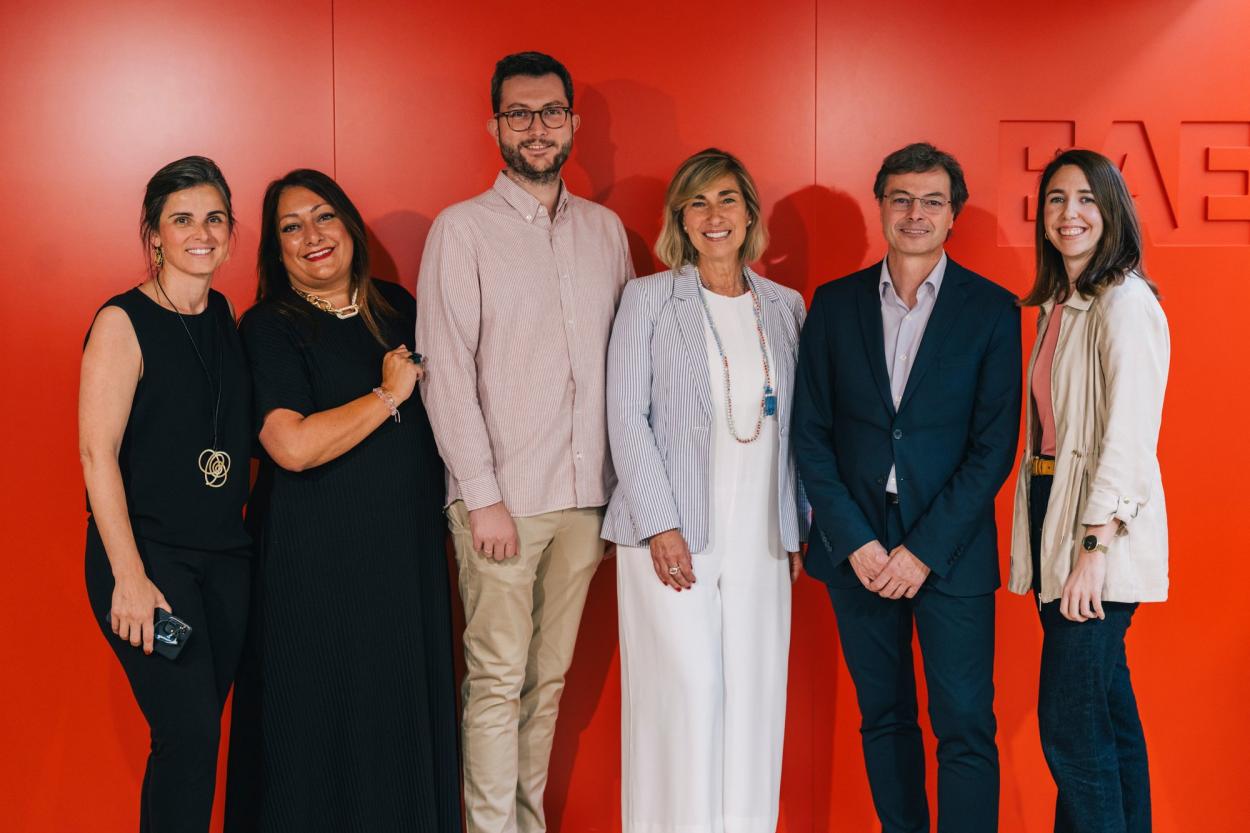
Collecting a package at a convenient pickup point pollutes 64% less than home deliveries
NACEX, Eroski, Mattel, Culinarium and Swarovski discussed the challenges faced by the retail sector in a forum held yesterday at the campus of EAE Business School Barcelona.
The retail sector is an important economic driver in Spain. It currently accounts for 4.7% of GDP and, since the pandemic, online sales have rocketed. However, the growth of electronic commerce and home deliveries also poses a huge challenge in terms of sustainability: delivery to a convenient pickup or collection point generates an average of 83 grams in CO2 emissions, a 63% reduction compared to home deliveries, which generate an average of 229 grams. This argument was put forward yesterday by representatives of the retail industry in a forum held at EAE Business School Barcelona in which Tatiana Valoira, Director of the Master in Fashion & Retail Management, presented the report “Trends in the retail sector”. The participants in the forum included Sheila Sastre, the Director of NACEX.shop; Ainhoa Oyarbide, the Brand & Communication Director of Eroski; Aysha Lezcano, the Iberia Area Manager of Swarovski; María Arostegui, the Customer Marketing Lead for Iberia at Mattel; and Carles Montori, the Director of Operations at Culinarium.
Collections at a convenient pickup point account for over 12% of e-commerce deliveries in Spain, which represents huge exponential growth. “Consumers have to get their heads around the fact that receiving packages at home is far less sustainable than collecting it from a location near to their homes, with a timetable that suits them”, explained Sheila Sastre, the Director of NACEX.shop. The collection point distribution company grew by 93.91% in the year of the pandemic. At a global level, e-commerce sales are expected to reach around 6 trillion euros in 2023 and surpass 7 trillion euros by 2025.
However, convincing consumers to collect a package from a pickup point instead of getting it delivered straight to their front door requires incentives. “Collecting at a delivery point should earn a reward: consumers need a financial incentive and a sustainability incentive”, explained Carles Montori, the Director of Operations at Culinarium, a kitchen utensil company that already has 28 stores across Spain.
"One key challenge is raising consumer awareness of the importance of collecting products from a delivery point to achieve greater sustainability throughout the e-commerce format"
OMNICHANNEL
Pure players (companies that only operate online) are redesigning some of their business to sell through physical stores as well, according to the report “Trends in the retail sector”, published by EAE Business School Barcelona. “The rise in e-commerce does not mean you should concentrate your business solely on online sales. Modern consumers want an omnichannel experience, with everything connected to give a unique and personalized experience. We have to innovate and, thanks to technology, it is easier to find new channels”, emphasized the lecturer Tatiana Valoira, the author of the report.
In the case of Mattel, the toy company with iconic brands such as Barbie, Hot Wheels and Fisher Price, the company experienced an huge boom in their online channel during the pandemic, which reached a share of 34% of total sales, with double-digit growth. “The rise is levelling off somewhat now but, looking at trends in other countries, the online business will keep on growing gradually. Consumers are continually on the move and combine online and offline experiences constantly. The omnichannel experience is here to stay and will take centre stage in the near future”, added María Arostegui, the Customer Marketing Lead for Iberia at Mattel.


IMPROVING THE IN-STORE EXPERIENCE
The coexistence of the online and offline channels has also led retailers to strive to improve the physical in-store experience as a way of boosting customer loyalty. “Customers are changing. They are increasingly well informed, demanding and impatient. The shopping experience has to be very fluid and personalized. There can’t be any friction”, explained Montori. At Swarovski, there has been a 360º change since the pandemic in terms of both the stores and the customer experience. “Some customers book an appointment to come to the store. Personalization is extremely important for us”, highlighted Lezcano.
Eroski emphasized that the company has chosen to change the tone of the brand to reach new audiences. “We decided to enhance our approachable tone against a really complex backdrop, with a proposition also designed to minimize the impact of inflation among consumers”, explained Ainhoa Oyarbide, the Brand & Communication Director of Eroski. “One of our main challenges this year is inflation of food and drink prices, as it has affected the way that households shop”, added Oyarbide. “At Eroski, right from the start, we make decisions that enable consumers to buy food at far more economical prices, trimming margins to ensure that inflation is not passed on to food prices”, explained Oyarbide.